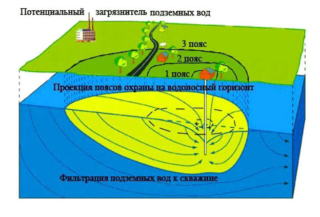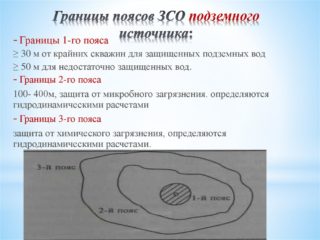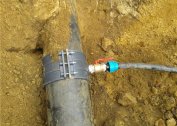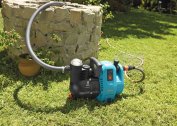An aquifer allows for autonomous water supply for residential buildings. The main stage of the hydraulic construction device is the organization of a sanitary protection zone around the drinking water well. It helps provide protection against bacterial and chemical contaminants.
Protection Zone Design
 The zone of protection of the artesian spring is a special space that ensures the safety of the structure, protects the earth and the aquifer from various pollution.
The zone of protection of the artesian spring is a special space that ensures the safety of the structure, protects the earth and the aquifer from various pollution.
When designing the ZSS and establishing its size, it is envisaged to carry out general work to protect the territory from polluting factors. The following data are taken into account:
- method of lifting water;
- water intake capacity;
- the depth of aquifers;
- distance from a septic tank or cesspool.
The protective space is organized by taking into account the data of various studies. They include the study of the microbiological environment, indicators of the aquifer. When arranging a well and creating a project for a protected area, coordination with the authorities of the sanitary-epidemic and housing control is required.
Belts and Bounding
 Three well protection zones should be present along the perimeter of the water intake source, ensuring sanitary and epidemiological reliability of the source.
Three well protection zones should be present along the perimeter of the water intake source, ensuring sanitary and epidemiological reliability of the source.
First belt
Dimensions are subject to watertight protection. If it is present, the radius from the water source located in the center is 30 m, in the absence - 50 m. A variety of water installations are located here. They are equipped with devices that prevent fluid contamination through the pipeline.
In the first belt it is prohibited:
- construction, installation and restoration work;
- the construction of technical buildings not related to the processing and supply of liquid;
- the construction of buildings and structures, even garden arbors;
- laying of pipelines, except for pipes for servicing hydraulic structures;
- discharge of drains, bathing, washing, fishing, grazing livestock.
The diameter can be reduced to 20 meters if the hydraulic structure has high sanitary-technical indicators, and the aquifer has reliable protection against polluting factors. A warning sign shall be installed at the border of the first belt.
Second belt
It is equipped to protect the hydraulic structure from bacterial contamination. The diameter of the plot is determined individually and can be:
- up to 500 meters - on the plains;
- from 700 meters - in mountainous and hilly areas;
- from 950 meters - on hilly areas, areas with uneven terrain;
- up to 3 kilometers - in the presence of surface water sources: rivers, lakes, reservoirs.
On this site it is impossible to equip farms for breeding animals and pastures, landfills for garbage collection, warehouses of substances with chemical activity. There should not be cemeteries, cattle cemeteries, sites for sewage disposal, filtration and irrigation, silos.
Third belt
The security zone of the water intake of the third belt implies coverage of the territory to prevent chemical contaminants from entering the well and the aquifer. The location of objects leading to infection with chemical, toxic and other hazardous substances is not allowed here.
It is impossible to equip here:
- chemical industry facilities;
- warehouses of chemicals, fertilizers and fuels and lubricants;
- sludge and wastewater storage tanks for industrial use;
- harmful production.
The size of the zone is determined individually for each type of aquifer. Calculation of the diameter of the sanitary site is carried out taking into account the time interval required for the penetration of bacterial and chemical pollutants into the water intake point.
The sanitary protection zones of hydraulic structures do not have specific operating periods, if you adhere to the basic requirements for the operation of wells. Without additional cleaning, they are able to function for at least 30 years.
Pollution management measures
 Are carried out during the design of the protected area, if the soil does not allow to provide adequate protection to aquifers. Such events include:
Are carried out during the design of the protected area, if the soil does not allow to provide adequate protection to aquifers. Such events include:
- drainage of storm water from areas for walking and other territories where animals and birds are located, with their collection in waterproofing storage tanks for storm water;
- additional waterproofing of the foundation and floors in industrial buildings located nearby;
- installation of reservoir and linear drainage systems that collect filtered water and solutions for pumping and further purification;
- the use of filtrated crushed stone layers with a network of pipes for drainage that discharge contaminated drains;
- Contraction of the contaminated liquids of aquifers into a depression funnel through special drainage wells or ditches.
In order to accurately determine the appropriate protection methods, biological and chemical indicators of water sources and soil structure are analyzed.
Measures for the arrangement of the well and the creation of the project must be coordinated simultaneously with the working draft for the water supply of the site.
Regulatory documents and liability for non-compliance
All standards for the organization of water protection zones are specified in SanPiN 2.14.1110-02. The design of the design and estimate documentation for the drinking and industrial water well is being developed by specialized organizations based on a hydrogeological report on the territory where the hydraulic structures are installed. It can be formed at the stage of drilling a pit or created specifically for an existing structure. Technical documentation is coordinated with the bodies of sanitary and epidemiological surveillance and housing control.
An appeal to the regulatory authorities for a new opinion is required in the following cases:
- the owner of the intake point has changed;
- there have been changes in the boundaries of the land, patterns of use of water intake;
- the amount of water use per day increased;
- organoleptic values decreased.
Conclusion is also necessary when plugging an old well or well.
In accordance with applicable law, penalties are provided for violating the rules for the use of water sources and wells, and non-compliance with sanitary standards. Penalties, depending on the degree of violation of regulatory acts, can reach half a million rubles. On average, they amount to 30,000 rubles. Culprits of serious pollution face criminal liability, which provides for arrest for a period of three months to five years.
The creation of protected areas is necessary to maintain the integrity of the well or well, protect the structure of the soil, and prevent pollution of the water-containing layer. When constructing buildings in the second and third zones, you need to be guided by sanitary standards and SNiPs. Such strict requirements will avoid mass epidemics and further environmental pollution.


